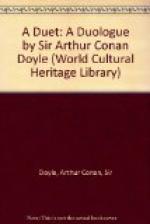‘No, sir.’
’And a fortunate thing for somebody. That woman’s husband would have a mean time of it, sir, in my opinion.’
‘Hush, poppa,’ said the two daughters, and the procession moved on. They were entering the inner chapel of all, the oldest and the holiest, in which, amid the ancient Plantagenet kings, there lies that one old Saxon monarch, confessor and saint, the holy Edward, round whose honoured body the whole of this great shrine has gradually risen. A singular erection once covered with mosaic work, but now bare and gaunt, stood in the centre.
‘The body of Edward the Confessor is in a case up at the top,’ said the guide. ’This hollow place below was filled with precious relics, and the pilgrims used to kneel in these niches, which are just large enough to hold a man upon his knees. The mosaic work has been picked out by the pilgrims.’
‘What is the date of the shrine?’ asked Frank.
’About 1250, sir. The early kings were all buried as near to it as they could get, for it was their belief in those days that the devil might carry off the body, and so the nearer they got to the shrine the safer they felt. Henry the Fifth, who won the battle of Agincourt, is there. Those are the actual helmet, shield, and saddle which he used in the battle upon the crossbeam yonder. That king with the grave face and the beard is Edward the Third, the father of the Black Prince. The Black Prince never lived to ascend the throne, but he was the father of the unfortunate Richard the Second, who lies here—this clean-shaven king with the sharp features. Now, ladies and gentlemen, if you will turn this way, I will show you one of the most remarkable objects in the Abbey.’
The object in question proved to be nothing more singular than a square block of stone placed under an old chair. And yet as the guide continued to speak, they felt that he had justified his words.
’This is the sacred stone of Scone upon which the kings of Scotland have been crowned from time immemorial. When Edward the First overran Scotland 600 years ago, he had it brought here, and since then every monarch of England has also sat upon it when crowned.’
‘The present Queen?’ asked some one.
’Yes, she also. The legend was that it was the stone upon which Jacob rested his head when he dreamed, but the geologists have proved that it is red sandstone of Scotland.’
’Then I understand, sir, that this other throne is the Scottish throne,’ said the American gentleman.
’No, sir, the Scottish throne and the English throne are the same throne. But at the time of William and Mary it was necessary to crown her as well as him, and so a second throne was needed. But that of course was modern.’
’Only a couple of hundred years ago. I wonder they let it in. But I guess they might have taken better care of it. Some one has carved his name upon it.’




